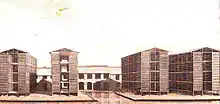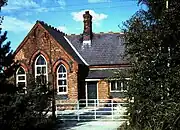North Forty Foot Bank
The North Forty Foot Bank is a settlement which runs about 6 miles (10 km) along the North Forty Foot Drain, about five to nine miles north-west of Boston Lincolnshire, England. It begins just south of the parish of Chapel Hill and runs along the drain to Toft Tunnel, just north of Hubberts Bridge. Despite its length, it only consists of the area on the north side of the drain, which was built in 1720 by Earl Fitzwilliam.[1] The North Forty Foot Bank forms the boundary between Harts Grounds and Pelhams Lands.

| North Forty Foot Bank | |
|---|---|
 North Forty Foot Drain | |
 North Forty Foot Bank Location within Lincolnshire | |
| OS grid reference | TF249477 |
| • London | 105 mi (169 km) S |
| Civil parish | |
| District | |
| Shire county | |
| Region | |
| Country | England |
| Sovereign state | United Kingdom |
| Post town | Boston |
| Postcode district | PE20 |
| Dialling code | 01205 |
| Police | Lincolnshire |
| Fire | Lincolnshire |
| Ambulance | East Midlands |
| UK Parliament | |
A row of 29 brick and slate cottages were built between the North Forty Foot Bank and the hamlet of Brothertoft by Major John Cartwright to accommodate the workers of his red brick woad mill in the late 18th century. This place was then called Isatica, which is Latin for "woad".[2] After Cartwright left Brothertoft for London, the hamlet of Isatica fell into ruin and disappeared.[3][4]
Formerly extra-parochial, the North Forty Foot Bank was created a civil parish in 1858, but in 1906 became part of the civil parish of Holland Fen with Brothertoft.[5]

Settlements within North Forty Foot Bank include:
- Pelhams Land
- Harts Ground
- Holland Fen
- Hedgehog Bridge lies about 5 miles (8.0 km) north west of Boston, Lincolnshire, on the North Forty Foot Bank. It was named after a hump-backed bridge over the drain which no longer exists. Hedgehog Bridge School was built in 1880 by the North-East Holland Fen School Board for 95 children.[6] It opened on 4 April 1881, became a Council School in 1903, and a County School about 1947. It finally closed in December 1969, and was demolished in 2010.[7][8][9][10]
- Toft Tunnel lies at the junction of the North Forty Foot Bank and the B1192 Langrick Road. Today it consists mainly of farms.[11]
References
- W. H. Wheeler (1868). "History of the Fens of South Lincolnshire". p. 44. Retrieved 6 May 2011.
- T. W. Bearstall (1978). Maurice Barley (ed.). Agricultural Revolution in Lincolnshire. The History of Lincolnshire Committee. p. 222. ISBN 0-902668-07-2.
- Arthur Young (1799). General View of the Agriculture of the County of Lincoln. Board of Agriculture. p. 35. Retrieved 6 May 2011.
cartwright brothertoft cottages.
- "Lincs to the Past". Lincolnshire Archives/English Heritage. Retrieved 6 May 2011.
- "Vision of Britain". University of Portsmouth. Retrieved 2 May 2011.
- "Kellys Directory 1919". Kellys Directories Ltd. p. 294. Retrieved 20 April 2011.
- "Lincs to the Past". Ref name SR/o83. Lincolnshire Archives. Retrieved 5 May 2011.
- http://www.british-towns.net/en/level_4_display.asp?GetL3=20496
- "Google Maps".
- "Geograph:: Footpath to Hedgehog Bridge © Richard Croft".
- "Google Map". Google Maps. Retrieved 2 May 2011.
External links
 Media related to North Forty Foot Bank at Wikimedia Commons
Media related to North Forty Foot Bank at Wikimedia Commons